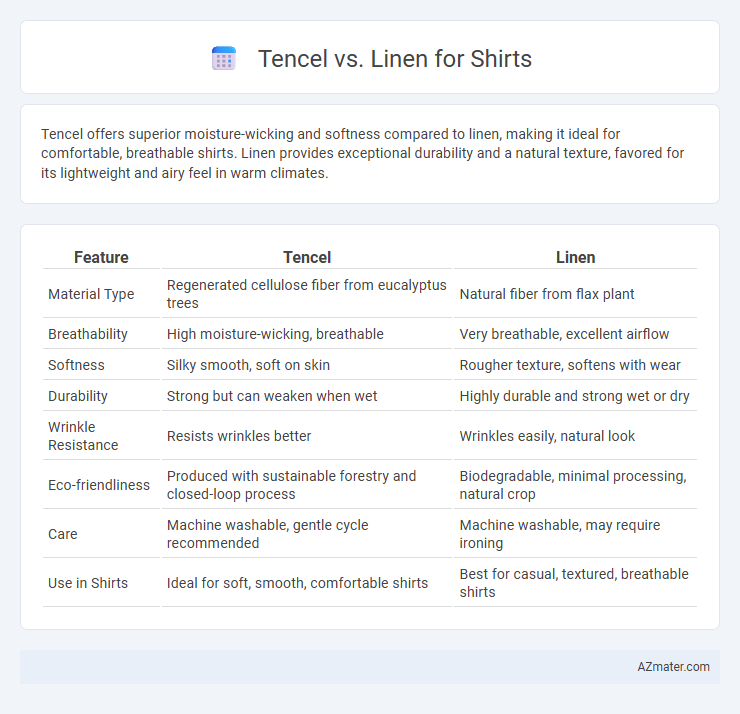Tencel offers superior moisture-wicking and softness compared to linen, making it ideal for comfortable, breathable shirts. Linen provides exceptional durability and a natural texture, favored for its lightweight and airy feel in warm climates.
Table of Comparison
| Feature | Tencel | Linen |
|---|---|---|
| Material Type | Regenerated cellulose fiber from eucalyptus trees | Natural fiber from flax plant |
| Breathability | High moisture-wicking, breathable | Very breathable, excellent airflow |
| Softness | Silky smooth, soft on skin | Rougher texture, softens with wear |
| Durability | Strong but can weaken when wet | Highly durable and strong wet or dry |
| Wrinkle Resistance | Resists wrinkles better | Wrinkles easily, natural look |
| Eco-friendliness | Produced with sustainable forestry and closed-loop process | Biodegradable, minimal processing, natural crop |
| Care | Machine washable, gentle cycle recommended | Machine washable, may require ironing |
| Use in Shirts | Ideal for soft, smooth, comfortable shirts | Best for casual, textured, breathable shirts |
Overview: Tencel vs Linen for Shirts
Tencel shirts offer exceptional softness, moisture-wicking properties, and sustainability through eco-friendly fiber production, making them ideal for sensitive skin and warm climates. Linen shirts provide superior breathability, natural texture, and durability, with excellent moisture absorption that enhances comfort during hot weather. Both fabrics are breathable and durable, but Tencel excels in smoothness and wrinkle resistance, whereas linen delivers a crisp, textured feel with a more traditional appearance.
Fabric Origins: Where Tencel and Linen Come From
Tencel fabric is derived from sustainably sourced eucalyptus wood pulp, processed through an environmentally friendly lyocell production method that minimizes water and chemical use. Linen originates from the flax plant fibers cultivated primarily in Europe, known for its natural durability and breathable qualities. Both fabrics are prized for their eco-conscious origins, with Tencel emphasizing renewable wood sources and Linen rooted in traditional agricultural practices.
Breathability and Comfort: Which Fabric Feels Better?
Tencel offers superior moisture-wicking properties and smooth texture, providing enhanced breathability and a soft, cool feel against the skin. Linen excels in natural airflow and durability, making it ideal for hot climates, though it has a rougher texture that softens with wear. For optimal comfort, Tencel suits those seeking silky softness and moisture control, while linen is preferred for its traditional breathability and crispness.
Moisture Management: Absorption and Quick-Drying
Tencel fibers exhibit superior moisture absorption capabilities, drawing perspiration away from the skin to keep wearers dry and comfortable throughout the day. Linen, while naturally breathable with moderate moisture-wicking properties, tends to retain moisture longer and takes more time to dry compared to Tencel. For shirts, Tencel's combination of high absorbency and rapid drying enhances comfort in humid or active conditions.
Durability: Longevity and Wear Resistance
Tencel shirts offer superior durability due to their moisture-wicking fiber structure and resistance to pilling, ensuring long-lasting wear and shape retention. Linen shirts, while known for breathability, tend to develop natural wear textures such as creases and thinning fibers over time, which may reduce longevity without proper care. Choosing Tencel provides enhanced wear resistance and sustained fabric integrity compared to linen's more delicate, natural aging process.
Sustainability: Eco-Friendliness Compared
Tencel, made from sustainably sourced wood pulp, uses a closed-loop production process that recycles water and solvents, significantly reducing environmental impact compared to traditional fabrics. Linen, derived from flax plants, is naturally biodegradable and requires fewer pesticides and less water than cotton, making it a highly eco-friendly textile. Both fibers offer sustainable benefits, but Tencel's controlled manufacturing and linen's minimal resource needs provide compelling options for environmentally conscious shirt production.
Maintenance: Washing and Care Instructions
Tencel shirts require gentle machine washing in cold water with mild detergent to maintain their softness and prevent fiber damage, while linen shirts benefit from hand washing or gentle machine cycles in lukewarm water to avoid shrinkage and preserve fabric texture. Both fabrics should be air-dried flat or on hangers to minimize wrinkles and maintain shape, but linen outfits tolerate steam ironing better due to their natural stiffness. Avoid bleach and high-heat drying for Tencel and linen to extend garment lifespan and keep fibers strong.
Style and Aesthetics: Look and Drape of Each Fabric
Tencel shirts offer a smooth, lustrous finish with a fluid drape that enhances a sophisticated, modern aesthetic, making them ideal for sleek, tailored styles. Linen exhibits a natural texture with a slightly coarse weave and characteristic wrinkles, creating a relaxed, airy look perfect for casual and summer wear. The crisp structure of linen contrasts with the softness of Tencel, influencing the overall silhouette and visual appeal of shirts depending on the desired style.
Cost Comparison: Price of Tencel Shirts vs Linen Shirts
Tencel shirts generally cost between $30 and $70, offering a budget-friendly option with a smooth, breathable fabric perfect for summer wear. Linen shirts often range from $50 to $120 due to the labor-intensive cultivation and weaving process, making them a pricier choice with a distinct texture and excellent moisture-wicking properties. The price difference reflects Tencel's eco-friendly, manufactured material versus linen's natural, traditional fibers.
Best Uses: When to Choose Tencel vs When to Choose Linen
Choose Tencel shirts for occasions requiring soft, breathable, and moisture-wicking fabric, ideal for active wear and sensitive skin due to its smooth texture and eco-friendly production. Opt for linen shirts in hot, humid climates where maximum airflow and durability are essential, making them perfect for casual summer outings and beachwear with their natural, textured feel. Both fabrics excel in sustainability, but Tencel offers superior wrinkle resistance, while linen provides a lightweight, crisp look.

Infographic: Tencel vs Linen for Shirt
 azmater.com
azmater.com